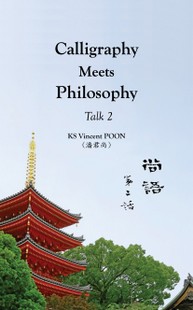Galleries and Translations > Recent Works / Buddhism > A Zen Poem by Longya Judun (III) (龍牙居遁禪詩一首) (三)
A Zen Poem by Longya Judun (III)
(龍牙居遁禪詩一首) (三)
95 X 42 cm in Clerical Script (隸書)
Translation
English Translation
Original Chinese
Living the Three Deeds (三事, 1) free of worries, I joyfully chant a melody (道情, 2),
三事無憂樂道情,
Only (且, 3) accompanying the clouds and waters, I never seek fame nor glory.
且陪雲水不求名.
Let (任) others (渠, 4) nevertheless (更, 5) interpret (解) that in all sorts of ways (千般, 6),
任渠更作千般解,
My nature (體, 7) inherently can never be blemished (瑕,8) nor stained gray.
體自無瑕不染青.
(Translated by KS Vincent POON, Nov. 16, 2022; calligraphy re-scribbed June 2023)
FOR FURTHER TRANSLATION, FOOTNOTES, AND ELABORATIONS
PLEASE SEE :

Calligraphy Meets Philosophy - Talk 2 尚語 - 第二話
by KS Vincent POON (Aug. 2023)
ISBN 978-1-989485-32-3
Content is the soul of an artwork.
Thus, catching the soul of Chinese calligraphy requires understanding the literary contents. To facilitate this, the Calligraphy Meets Philosophy series presents traditional Chinese calligraphy alongside line-by-line translated texts with remarks and footnotes.
Calligraphy Meets Philosophy – Talk 2 (《 尚語∙第二話 》) includes calligraphies and translations of selected literary works by Cao Cao (曹操, 155-220 AD), Zhuge Liang (諸葛亮, 181-234 AD), Yen Shang (楊慎, 1488–1559 AD), Bai Juyi (白居易, 772-846 AD), Li Bai (李白, 701-762 AD), The Nun of the Wujinzhan (無盡藏比丘尼, ?-?AD), Wuzu Fayan (五祖法演, ?-1104AD), Longya Judun (龍牙居遁, 835-923 AD), and Kuiji (窺基, 632-682 AD).The book concludes with the author’s artwork of the entire Diamond Sutra (《 金剛般若波羅蜜經 》), followed by a short remark.
WorldCat/Library: [U of Oxford] [U of Cambridge] [Kyoto U] [Columbia U] [HKU] [National Palace Museum Taiwan] etc...
Jump to: Buddhism
Jump to: Works in Clerical Script